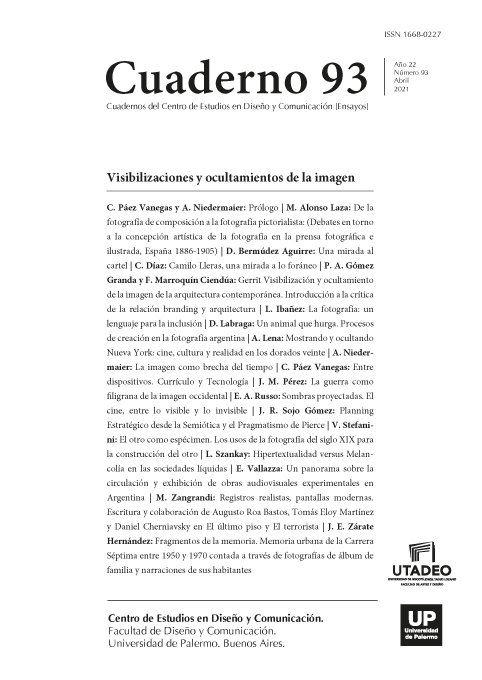Fragmentos de la Memoria. Memoria urbana de la Carrera Séptima entre 1950 y 1970 contada a través de fotografías de álbum de familia y narraciones de sus habitantes
Abstract
The memory can be seen as a way of becoming aware of itself or as a form of inheritance that leaves a generation to those who succeed. This research is a visual journey through the concepts of memory and forgetfulness. The memory is constituted by a high sensible load, that feeds on the individual memories of the subjects and that, when being annexed to the colectivity, it becomes visible, so that it can be turned into a form of expression of the urban memory of a group and, in this way, load of meaning the moments of the existential space experience by the subject. The question on which this research is constructed focuses on the way in which the urban memory of the Carrera Séptima de Bogotá between 1950 and 1970 can be reconstructed through the analysis of photographs taken from family albums and stories of its inhabitants. This research acquires power as a document insofar as the subjects who access it, perceive it as a concretion of the experience of the existential space of the citizen of the epoch in question, loading the narrations and the images gathered here of symbolism, in their own lived experience.
References
Alcaldía Mayor, Departamento Administrativo de Planeación Distrital. (2000) páginas 174, Bogotá, Colombia.
Arfuch, Leonor (Compiladora). (2009). Pensar este tiempo, espacios, afectos, pertenencias. Editorial Paidós.
Benjamín, Walter (1972). Discursos interrumpidos I “Filosofía del arte y de la historia”. Editorial Taurus
Burke, Peter (2005). Visto y no visto. El uso de la imagen como documento histórico. Editorial critica Barcelona, Barcelona.
Cacciari, Massimo. (2009). La ciudad (4ta edición). Barcelona: Editorial Gustavo Gili.
Entwistle, Joanne (2000). El cuerpo y la moda, una visión sociológica. Paidos Contextos. Barcelona, España
François Fourquet, Alberto Szpunberg, Lion Murard. (1978). Los equipamientos del poder: ciudades, territorios y equipamientos colectivos. Editorial Gustavo Gili, España
Gónzalez, Sady. (2007). Bogotá, años 50, Revista Número Ediciones, páginas 214, Colombia.
Halbwachs, Maurice (2004). Los marcos sociales de la memoria. Editorial Anthropos.
Hall, Edward T. (1989). Apuntes del lenguaje silencioso. Alianza Editorial. Madrid, España.
Mandoky, Katya (2006). Prácticas estéticas e identidades sociales. Prosaica dos. Siglo Veintiuno Editores. Conaculta Funca.
Páramo, Pablo. Cuervo, Mónica. (2009). La experiencia urbana en el espacio público de Bogotá en el siglo XX. Una mirada desde las prácticas sociales. Editado por la Universidad Pedagógica Nacional, Bogotá.
Saldarriaga, Roa. Alberto (2000). Bogotá siglo XX urbanismo, arquitectura y vida urbana. Capítulo 4: El siglo XX y la vida urbana. Departamento Administrativo de Planeación Distrital, Bogotá Colombia.
Schulz, Norberg Christian (1975). Existencia, espacio y arquitectura. Editorial Blume. Barcelona.
Sontang, Susan, (1977). Sobre la Fotografía. Editorial Alfaguara.
Suárez Ferreira, Helbert. (2009). Evolución de la "Calle Real del Comercio", Santafé de Bogotá. Tesis de grado obtenido no publicada. Universitat Politècnica de Catalunya, Cataluña, España.
Los autores/as que publiquen en esta revista ceden los derechos de autor y de publicación a "Cuadernos del Centro de Estudios de Diseño y Comunicación", Aceptando el registro de su trabajo bajo una licencia de atribución de Creative Commons, que permite a terceros utilizar lo publicado siempre que de el crédito pertinente a los autores y a esta revista.


